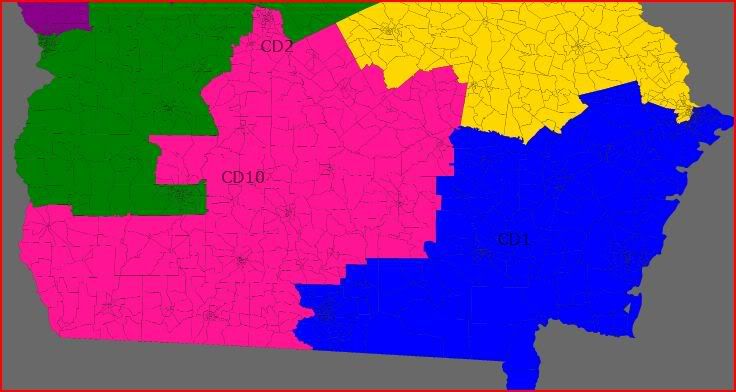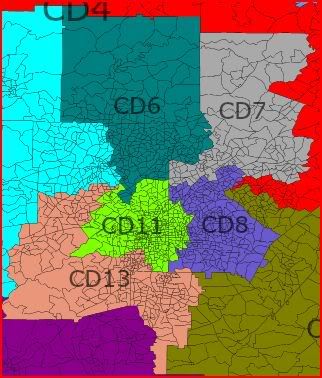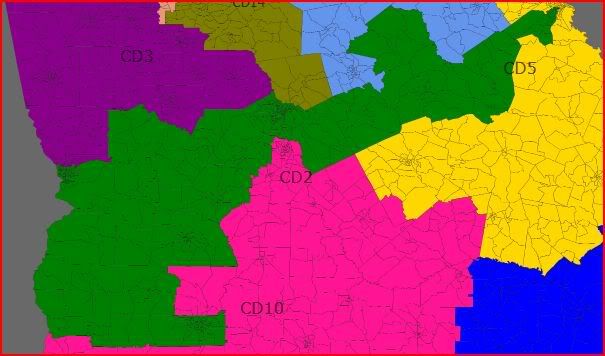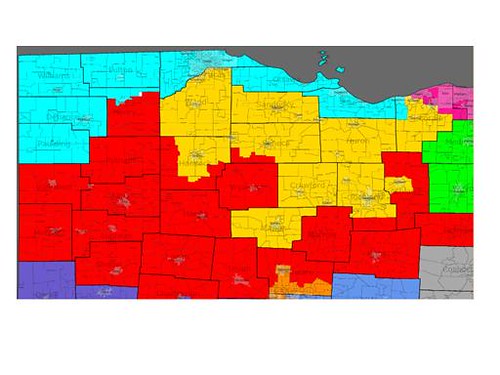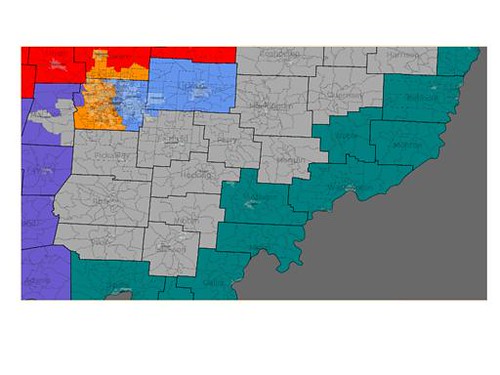I decided to take on Arizona with its unique redistricting rules. Contrary to many states, Arizona focuses less on incumbent protection and even competitiveness, and more on “communities of interest” (though doesn’t really provide a clear definition for what this means). Additionally, as evidence by the 2000 map which sought unsuccessfully to make Arizona a 5R-3D state in line with its partisan leanings, they will very likely address the fact that the current 5D-3R doesn’t look like Arizona either and draw definitely one and likely both of the new districts so that they elect Republicans. On the same token I’d expect them to address the fact that there’s sort of a problem when Obama won 45% of the vote here yet he has the potential to only have won 2 of the 10 districts, so thus I chose to create a 3rd Obama district. As they do kinda take into consideration competitiveness, at least as an afterthought, 5 of the 8 old districts are now closer to 50-50 than they were before. I opted not to create a 3rd Hispanic-majority district, as I really don’t think that a third one will be mandated by the Justice Department. In fact, as best as I can tell, AZ-07 wasn’t required in 2000, either (remember, despite popular opinion whenever someone redistricts Louisiana here, the Justice Department doesn’t actually require that the percent of districts that a state has that are minority-majority must be equal to the percent of it’s population that is Hispanic (otherwise Texas would look much, much better for us)). However, they will likely require that there is a working Hispanic majority in a second district, thus AZ-07 should see a bit of an uptick in its Hispanic population. That being said, it’s still a very legitimate possibility that the redistricting commission opts to create a 3rd Hispanic-majority district anyway, though there probably isn’t a strong a “community of interest” argument for one this time around (as the two largest Hispanic communities, South Phoenix & the border, are already covered and the next largest, the southern part of the West Valley, doesn’t really have a large enough Hispanic community just yet.
I calculated political data based off these maps for the 2004 and 2008 presidential races to provide more depth to this map, as I’ve noticed that a lot of the recent maps rely on at best educated guesses for what the actual political realities are on the ground. While I’m confident enough in my data to post it, it likely isn’t perfect. Arizona doesn’t have townships or anything like that, so sometimes it’s difficult to figure out exactly where precincts belong. Additionally, I’d like to thank Dave and his awesome Redistrict Application, which made this possible.
Finally, I’m perfectly aware that the nature of the rules in Arizona means that someone could come in with the same basic goals that I have and come out with a very different map, so I’d love to here what other people have to think.



AZ-01 (Blue): Rep. Ann Kirkpatrick, R+3.4
-Flagstaff, Douglas, Payson
54% White, 23% American Indian, 19% Hispanic
More rural than ever (Flagstaff is the only town larger than 20K), the new AZ-01 drops the urban-suburban regions of Pinal County while maintaining its decidedly rural and Hispanic eastern edge, and pulls out of most of the rapidly urbanizing Prescott area, hanging on to only the more rural edges like Chino. Meanwhile, it picks up the ranching region of Cochise County (which like the rest of the Anglo population of eastern Arizona, has become quite conservative but remains somewhat Dem-friendly at the local level) along with some more liberal border towns; I’d argue that Cochise County outside SV makes a lot more sense in Kirkpatrick’s district than Giffords’ from the communities of interest POV.
The ditching of Evangelical-heavy Prescott does help to make this district somewhat more Democratic, but it also means that it’s trending Republican faster than ever as that corridor of Mormons, ranchers, and miners in Eastern AZ starting South of the Navajo Nation and ending somewhere immediately north of Douglas and Bisbee grow more Republican by the minute (and it won’t have the potentially Dem-trending suburbs of Pinal County to counteract that anymore). This may be a genuine Gore-Bush-McCain district, though, and the possibility is quite good that Obama wins it in 2012 if he carries AZ.
John McCain won 52% of the vote here in 2008.
| Counties |
Obama |
McCain |
Others |
Total |
|
Kerry |
Bush |
Others |
Total |
| Apache |
15390 |
8551 |
295 |
24236 |
|
15658 |
8384 |
156 |
24198 |
| Cochise (part) |
10534 |
13661 |
420 |
24615 |
|
10272 |
12096 |
285 |
22653 |
| Coconino (part) |
31248 |
22126 |
723 |
54097 |
|
29030 |
22465 |
383 |
51378 |
| Gila |
7884 |
14095 |
337 |
22316 |
|
8314 |
12343 |
186 |
20843 |
| Graham |
3487 |
8376 |
144 |
12007 |
|
3185 |
7467 |
68 |
10720 |
| Greenlee |
1165 |
1712 |
36 |
2913 |
|
1146 |
1899 |
22 |
3067 |
| Maricopa (part) |
1091 |
809 |
40 |
1940 |
|
1138 |
696 |
14 |
1848 |
| Navajo (part) |
14879 |
19592 |
455 |
34926 |
|
14035 |
17116 |
247 |
31398 |
| Pinal (part) |
4328 |
4512 |
116 |
8956 |
|
4420 |
3909 |
59 |
8388 |
| Yavapai (part) |
17885 |
27393 |
705 |
45983 |
|
16091 |
23516 |
329 |
39936 |
| Total |
107891 |
120827 |
3271 |
231989 |
|
103289 |
109891 |
1749 |
214929 |
AZ-02 (Red): Rep. Trent Franks, R+7.5
-Glendale, western Phoenix, Avondale
55% White, 33% Hispanic, 5% Black
While I ended up opting against drawing an Arizona map with a third Hispanic majority district (though there’s a good argument for one and that may be my next project), I did have to address the fact that there’s a relatively large and rapidly growing Hispanic population in Phoenix’s suburb’s southern West Valley that is currently mostly in 7th. I decided that a Phoenix district had to take them on to maximize their voice, and the Glendale-based 2nd district was the obvious choice. Additionally, as I ceded Peoria & the exburbs to the new 9th, this district had to go deeper into western Phoenix, now going clear east to I-17 though northern and much of central Phoenix and has to take in a few precincts in south western Phoenix for population purposes.
Trent Franks would find himself in a bit of pickle. On one hand this district is clearly Dem-trending (I could see it voting Democratic on the presidential level as early as 2012) and the growth of the Hispanic population will eventually drown him. Meanwhile, there’s an invitingly Republican district directly to the West and surely most of the conservative establishment, much of which was represented by Franks for the past 6 years anyway, will bow to this noted douchebag far-right luminary. That being said, Franks has a coveted seat on the Armed Services committee–a seat he may lose if he’s chooses not to represent Luke Air Force Base, which is still in the 2nd along with most of its employee. If Franks were to decide he only supports the troops when they’re in safe districts and bails, Republicans would still have a pretty good chance of holding this district with State Sen. Linda Gray or Glendale mayor Elaine Scruggs being potentially leading candidates, though we’d have a legitimate shot with someone like Avondale mayor Marie Lopez Rogers. Otherwise, look for Franks to be in the race of his life sometime around 2014.
John McCain won 54% of the vote here in 2008.
| Counties |
Obama |
McCain |
Others |
Total |
|
Kerry |
Bush |
Others |
Total |
| Maricopa (part) |
86328 |
103617 |
3250 |
193195 |
|
69754 |
94108 |
1050 |
164912 |
AZ-03 (Purple): Rep. John Shadegg, R+12.0
-Northern Phoenix, northern Scottsdale, New River
83% White, 11% Hispanic
Based around the tract homes and gated communities of McMansions that have popped up in northern Maricopa County here in the last 20 years, this is probably the wealthiest district in Arizona. It sheds much of the more culturely liberal neighborhoods in central Phoenix, now beginning north of Camelback and the North Mountains which gives it a decidedly suburban character despite the fact that the majority of its inhabitants live in the Phoenix city limits. Most people here commute to 4th and the 5th, though there is a substantial central business district in the 3rd’s new portion of Scottsdale–which I decided to include because there’s a division between the more middle-class southern and downtown Scottsdale and the disgustingly wealthy northern Scottsdale. In any event, Shadegg will fit here like a glove, as this district is safely Republican.
John McCain won 59% of the vote here in 2008.
| Counties |
Obama |
McCain |
Others |
Total |
|
Kerry |
Bush |
Others |
Total |
| Maricopa (part) |
115630 |
174838 |
4313 |
294781 |
|
95226 |
151454 |
1231 |
247911 |
AZ-04 (Grey): Rep. Ed Pastor, D+15.4
-Southern Phoenix, Guadalupe
71% Hispanic, 17% White, 8% Black
The southern Phoenix based 4th district doesn’t change that much, just shrinking because of population growth and becoming even more Hispanic. There are some upper class subdivisions in the Laveen area, but by in large this is working-class urban district that will continue to be the most Democratic district in Arizona.
Barack Obama won 68% of the vote here in 2008.
| Counties |
Obama |
McCain |
Others |
Total |
|
Kerry |
Bush |
Others |
Total |
| Maricopa (part) |
62390 |
27826 |
1398 |
91614 |
|
43697 |
24414 |
482 |
68593 |
AZ-05 (Yellow): Rep. Harry Mitchell, D+2.6
-Central Phoenix, Tempe, southern Scottsdale
58% White, 29% Hispanic
As I mentioned above, the fact that there is a big potential for this map to only have two districts out of ten that Obama won when he pulled off a respectable 45% of the vote is kind of a problem. If it took some kind of massive gerrymander to ameliorate that situation then it would be a problem, but I’d argue that this district is just as logical if not more so than the current AZ-05.
Essentially, I tried to create a “creative class” district that is well educated but more culturally liberal than the 3rd on the other side of the mountains. Starting in Tempe (home to ASU and several software companies) it moves up through several middle-class southern Scottsdale neighborhoods and then artsy downtown Scottsdale, then turns West into Phoenix to take in several historic middle-class neighborhoods such as Arcadia and Encanto before turning north again to end at the traditionally working-class but gentrifying Sunnyslope. One thing that occurred to me just as I was writing this up is that ASU’s Downtown Campus is a just a couple miles the south of Encanto area and ASU west is just a couple miles to the northwest of Sunnyslope, so if I were to redraw this map, adding those two campuses into this district would be one of my first priorities.
This would probably be pretty safe for Democrats (though Republicans do definitely have a base here) but the bigger threat to Harry Mitchell might be a primary challenge out of Phoenix and from the left. State Rep. (and de facto future State Sen.) Kyrsten Sinema, who represents much of the Phoenix portion of this district already and is seen as a major rising star in the liberal wing of the state party would probably take a look (incidentally, she’d be the first openly bisexual member of congress).
Barack Obama won 54% of the vote here in 2008.
| Counties |
Obama |
McCain |
Others |
Total |
|
Kerry |
Bush |
Others |
Total |
| Maricopa (part) |
96261 |
78728 |
3469 |
178458 |
|
88501 |
79006 |
1231 |
1687382 |
AZ-06 (Teal): Rep. Jeff Flake, R+13.5
-Mesa, Apache Junction, northern Gilbert
71% White, 22% Hispanic
The current version of this district has swelled to become the largest in Arizona, so it needed to shed quite a bit of territory. It now takes in the entirety of Mesa (picking up the westside that was shed by the 5th) but loses its portion of Chandler, almost of Gilbert, and all of Queen Creek & the San Tan Valley. Mesa, which has sizable Mormon and retired communities, is starting to become more diverse with a growing Hispanic minority, and may eventually be at the center of a swing district. In the short-term, however, it should continue to be one of the Republican strongholds in the interior West.
John McCain won 60% of the vote here in 2008.
| Counties |
Obama |
McCain |
Others |
Total |
|
Kerry |
Bush |
Others |
Total |
| Maricopa (part) |
72159 |
114697 |
3793 |
190649 |
|
64189 |
114338 |
1038 |
179565 |
| Pinal (part) |
8099 |
12268 |
257 |
20624 |
|
7633 |
11114 |
92 |
18839 |
| Total |
80258 |
126965 |
4050 |
211273 |
|
71822 |
125452 |
1130 |
198404 |
AZ-07 (Cyan): Rep. Raul Grijalva, D+8.9
-Western Tucson, most of Yuma, Nogales
57% Hispanic, 33% White
While from the best information I can gather, this district was not actually mandated by the Justice Department, thus the fact that it was only 50.6% Hispanic in 2000 and was basically reliant on White liberals in Tucson to ensure the election of a Hispanic. However, with Arizona pushing 30% Hispanic, only one district where Hispanics are decidedly in the drivers seat isn’t going to do it, thus making the 7th a little more Hispanic was a major priority. It pulls out of Maricopa County for population reasons (except for that small part on the Tohono O’odahm Rez) and Pinal County because, despite what DRA says, that region has swelled somewhere north 40K and is decidedly suburban, making the prospect that it is still majority Hispanic highly unlikely. Taking suburban Yuma out of the district goes a long way, and allows this district to become more Hispanic while only making minor alterations to the Tucson area. It should continue to be safely Democratic, especially if Republicans keep nominating that White supremacist.
Barack Obama won 59% of the vote here in 2008.
| Counties |
Obama |
McCain |
Others |
Total |
|
Kerry |
Bush |
Others |
Total |
| Maricopa (part) |
17 |
12 |
0 |
29 |
|
40 |
4 |
0 |
44 |
| Pima (part) |
73583 |
42308 |
1505 |
117396 |
|
70118 |
38064 |
721 |
108903 |
| Pinal (part) |
115 |
34 |
0 |
149 |
|
174 |
34 |
0 |
208 |
| Santa Cruz (part) |
7259 |
3222 |
65 |
10546 |
|
5637 |
3397 |
50 |
9084 |
| Yuma (part) |
16066 |
19428 |
334 |
35828 |
|
13762 |
18259 |
173 |
32194 |
| Total |
97040 |
65004 |
1904 |
163948 |
|
89731 |
59758 |
944 |
150433 |
AZ-08 (Pink): Rep. Gabrielle Giffords, R+4.3
-Eastern Tucson, Casas Adobes, Catalina Foothills
74% White, 17% Hispanic
Certainly the district that changes the least as far as presidential performance, though I did try to make it more urban-suburban based and more military-centric by dropping rural Cochise County to the 1st. This should be another district that Obama wins in 2012 if he manages to carry the state.
John McCain won 52% of the vote here in 2008.
| Counties |
Obama |
McCain |
Others |
Total |
|
Kerry |
Bush |
Others |
Total |
| Cochise (part) |
8409 |
15365 |
397 |
24171 |
|
7242 |
14460 |
128 |
21830 |
| Pima (part) |
132618 |
141801 |
3108 |
277527 |
|
122890 |
132694 |
1387 |
256971 |
| Pinal (part) |
2660 |
3953 |
40 |
6653 |
|
2014 |
3221 |
16 |
5251 |
| Santa Cruz (part) |
1424 |
1296 |
36 |
2756 |
|
1272 |
1271 |
30 |
2573 |
| Total |
145111 |
162415 |
3581 |
311107 |
|
133418 |
151646 |
1561 |
286625 |
AZ-09 (Green): NEW, R+14.3
-Peoria, Surprise, Prescott
77% White, 16% Hispanic
The fact that the Republican performance in several districts decreased should balance out the fact that this district will now be the most Republican in Arizona. If AZ-01 is the rural district, this is the medium-sized town district, encompassing most of the Prescott-Prescott Valley area, Bullhead City, Kingman, Lake Havasu City, and suburban Yuma. However, a little more than half of its population lives in the West Valley of Phoenix, as evidenced by the fact that rapidly growing Peoria and Suprise are the two largest cities. The Sun City area rounds out this heavily conservative district’s tilt and contributes to a large retired population along with Mohave County.
This district is pretty much impregnable for us. As I mentioned, Trent Franks would probably seriously consider running out here. If not, potential new representatives include current SOS and former State Senate President Ken Bennett, current State Senate President Bob Burns (though he’d be 74 on election day 2012, so that might not be realistic), State Sens. Steve Pierce and Jack Harper, though it would probably a five-ring frakus no matter what happens.
John McCain won 62% of the vote here in 2008.
| Counties |
Obama |
McCain |
Others |
Total |
|
Kerry |
Bush |
Others |
Total |
| Coconino (part) |
185 |
60 |
2 |
247 |
|
213 |
61 |
2 |
276 |
| La Paz |
1929 |
3509 |
114 |
5552 |
|
1849 |
3159 |
48 |
5055 |
| Maricopa (part) |
67007 |
109897 |
2865 |
179769 |
|
47540 |
77762 |
525 |
125827 |
| Mohave |
22092 |
44333 |
1180 |
67605 |
|
20503 |
36794 |
510 |
57807 |
| Navajo (part) |
704 |
169 |
5 |
878 |
|
780 |
161 |
4 |
945 |
| Yavapai (part) |
19011 |
33789 |
756 |
53556 |
|
17036 |
29952 |
283 |
47271 |
| Yuma (part) |
2493 |
5149 |
120 |
7762 |
|
2270 |
3925 |
34 |
6229 |
| Total |
113421 |
196906 |
5042 |
315369 |
|
90191 |
151813 |
1406 |
243410 |
AZ-10 (Indigo): NEW, R+10.1
-Chandler, most of Gilbert, Ahwatukee Foothills
62% White, 25% Hispanic
The second new district pairs the rapid growth in southeastern Maricopa County with the rapid growth in western Pinal County to create a district that had barely more than 100K residents 25 years ago. Their remains some agriculture (mainly in Pinal County) and some Native Americans (the awkward reentry of the district into Maricopa County west of the 4th district is so that it can take in the rest of the Gila River Indian Reservation; Indian Reservations cannot and will not be broken up, btw, so please don’t suggest that in your comments), but it’s identity is first and foremost suburban. The sizable Hispanic community and swing areas like Ahwatukee could help make this district competitive, but any Democratic candidate will have to struggle to not be absolutely demolished in Gilbert and the San Tan Valley.
Politically, it leans pretty strongly Republican and was drawn to elect one, but there is some potential that it could end up in a Democrat’s hands. Potential Republican candidates include State Senate President pro tempore Thayer Verschoor and State House Majority Leader John McCormish. Democratic State Senate Assistant Minority Leader Rebecca Rios, who represents the Pinal County portion of the district and will be term limited in 2012 anyway, may be able to make this a horse race.
John McCain won 57% of the vote here in 2008.
| Counties |
Obama |
McCain |
Others |
Total |
|
Kerry |
Bush |
Others |
Total |
| Maricopa (part) |
93790 |
126879 |
3301 |
223970 |
|
71363 |
108729 |
885 |
180976 |
| Pinal (part) |
29052 |
38652 |
795 |
68499 |
|
13011 |
18728 |
166 |
31905 |
| Total |
122842 |
165531 |
4096 |
292469 |
|
84374 |
127456 |
1051 |
212881 |

